Kansas City Royals Top Ten Prospects For 2017

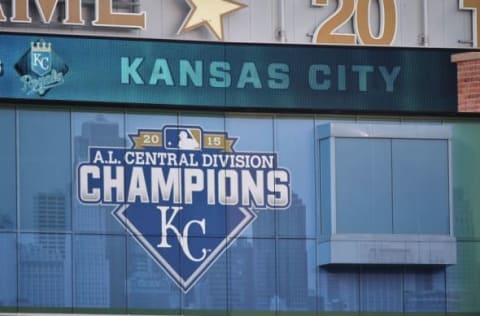
After two seasons finishing the year in the World Series, the Kansas City Royals missed the playoffs in 2016. Do they have the reinforcements to make another run in 2017?
An Introduction
Our minor league top 10 series is coordinated by Benjamin Chase, one of our contributors at Call To The Pen.
He has poured over thousands of minor league games over the course of the year via milb.tv along with speaking with a number of team and independent scouts. These lists are based out of those conversations.
Each system will have prospects from 10 to 1, and then finish with one newcomer to the system that is worth keeping an eye on that is not in the top 10 at this time.
Conversations are certainly encouraged in the comments section on each system as we go along!
The Royals have used that elite farm system to fund those two World Series runs, both on the field and through trades
Royals System Review
Three years ago, the discussion was about whether we’d ever seen a minor league system as loaded as the Kansas City Royals had been from 2011-2013. Now, after a multiple year run that saw them fall an improbable Madison Bumgarner run short of back-to-back World Series titles, the team has to do some evaluation of where they are going forward with that crop of players as they begin to hit free agency.
Last offseason, the Royals addressed their first free agent from their big prospects grouping in Alex Gordon, bringing him back on what many in the industry considered a sign of the concession that the Royals knew they had a limited window of time left being competitive before they’d need to retool their roster, as they chose to sign Gordon for less years and more money rather than lock him down for an extended deal.
The Royals have used that elite farm system to fund those two World Series runs, both on the field and through trades, as they’ve seen Sean Manaea, Wil Myers, Brandon Finnegan, Mike Montgomery, Jake Odorizzi, John Lamb, Cody Reed, and Brett Eibner be moved in deals to pursue the playoffs the last three years after being highly rated prospects at some point within the Royals system.
In general, you will always do that trade off, as the saying goes, “flags fly forever”, however, it’s now left the Royals system fairly shallow in high-end talent with many of their current roster due to hit free agency in the next two offseasons and getting far too expensive for a small market team to keep together.
The direction the team takes this season will likely be determined at Memorial Day. If you see the team competing and playing well, they’ll likely stay the course and hope for the system to fill needs to make one more run on the current roster. If they’re falling behind due to poor performance or injury (as was the case in 2016), you could see the Royals put players like Wade Davis, Alcides Escobar, Jason Vargas, Lorenzo Cain, Mike Moustakas, Eric Hosmer, and Danny Duffy on the market, as they are all free agents after 2017, and you could imagine they would see a farm system turnaround akin to the turn around that the Milwaukee Brewers have put together in the last two seasons, but instead doing it over about three months!
Let’s check out the top 10!
Next: #10
10. Seuly Matias, OF
Birthdate: 9/4/98 (18 years old)
Level(s) Played in 2016: rookie
Stats in 2016: .250/.348/.477, 8 HR, 2 SB
Arguably the most toolsy player in the entire system, Matias was signed last July 2nd out of the Dominican Republic. Scouts loved his bat speed and defensive ability coming into the signing period.
Matias got a brief introduction at the Dominican Summer League until the Arizona Fall League opened as the Royals got as many reps for Matias as possible. He’s already filled out his 6’3 frame to roughly 215 pounds, yet he’s easily able to handle center field due to high-level athleticism.
I did have a couple of scouts voice concern that Matias grew possibly too quickly for his own good as he could struggle with “bad weight” and the effect this has on his speed on the bases and one scout reported it altered his swing path.
The raw power is absolutely still there, however, and I had a report as high as 75 on the 20 to 80 scale on his raw power ability, which is an incredibly elite number. He showed the raw-ness you’d expect from a guy in his first exposure to professional ball in controlling the strike zone, with way too much swing and miss, but it’s hard to argue with the 22 extra base hits in just 196 total at bats.
Matias will likely be bumped to the Pioneer League next season, and if his body filling out causes him to move off center field, his plus-plus arm in the outfield will allow him to be a solid right fielder.
Next: #9

9. Jorge Bonifacio, OF
Birthdate: 6/4/93 (23 years old)
Level(s) Played in 2016: AAA
Stats in 2016: .277/.351/.461, 19 HR, 6 SB
One of the more divisive prospects in the Royals system, Bonifacio is the brother of Emilio Bonifacio, though there’s little similar between the utility infielder/outfielder with plus speed and his hulking brother.
Bonifacio’s offensive game has always been keyed on his ability to punish the baseball, but the problem has been making consistent contact to use that power rather than just swinging for the fences. He still strikes out plenty, but he’s cut down plenty in the last season.
Bonifacio’s offensive game has always been keyed on his ability to punish the baseball
From my views this season, I felt that Bonifacio sacrificed the unique sound off his bat that he used to get in pursuit of shortening his swing, and while he still is an above-average prospect offensively, he has cut down his ceiling plenty if he’s going to have to limit his ability to crush the ball in order to just get to a passable level of swing and miss.
Bonifacio will get plenty of shots with his bat as his glove work in right field is an asset. He brings a plus arm to the fold, and he uses excellent instincts to track down balls quite well. He should be part of an interesting prospect-laden competition for the right field job in spring training this coming year.
Next: #8
8. Chase Vallot, C
Birthdate: 8/21/96 (20 years old)
Level(s) Played in 2016: rookie, low A
Stats in 2016: .235/.356/.454, 15 HR
Vallot got a lot of attention as a draft prospect out of high school in 2014 due to his raw power, winning a home run derby at a Perfect Game showcase the summer before his senior year and then hit a ton of home runs in his senior year as well.
The Royals selected Vallot #40 overall, assuming he would take some time to develop as a catcher, but wanting to develop the power behind the plate. Instead, they got a catcher who has been considered borderline elite behind the plate.
Vallot’s power is certainly present, and there’s been no doubt about that along the way
Vallot has a plus arm that allows him to rifle the ball to second base, elite framing skills, and he gets very high praise for his pitch calling and the way he handles his pitchers. He still has some work to do in his footwork behind the plate, both in the run game and in blocking pitches, but the defensive profile is very strong.
Vallot’s power is certainly present, and there’s been no doubt about that along the way, but he’s struggled to translate his solid quick swing into consistent contact. He seems to have solid pitch recognition at the plate, but he gets too homer-happy, and swings through a number of pitches when he tends to get long in his back end of his swing, hurting his ability to adjust to pitches.
Vallot’s bat speed and raw power should allow him to profile as a guy who could hit for a .250-.270 batting average, but he will need to be willing to take a walk. While he’s often passed over by others, he’s one of my favorite catching prospects in the game due to his already-present defensive profile along with his high-end power.
Next: #7
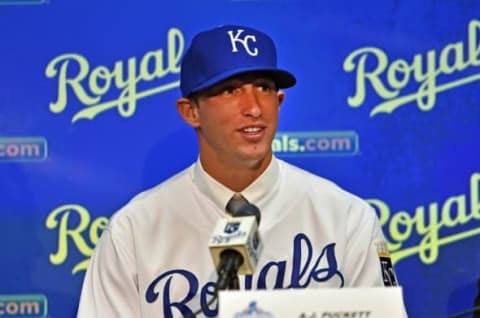
7. A.J. Puckett, RHP
Birthdate: 5/27/95 (21 years old)
Level(s) Played in 2016: rookie, low A
Stats in 2016: 58 2/3 IP, 3.68 ERA, 1.11 WHIP, 6.33 BB%, 18.99 K%
Many are familiar with the profile of the “command and control lefty”, indicating a left-handed starter that uses excellent command and control of his pitches rather than raw action of his pitches to manipulate hitters and get weak contact.
Puckett fits that profile to a T, but he’s coming from the right side instead. He doesn’t have a monster fastball, touching 94, but sitting 89-92, but with excellent run, sink, or cut depending on how he grips the pitch.
He also works with an elite change that showed plus in my viewings, with a similar ability to cut and sink the pitch depending on how he gripped the pitch along with excellent arm deception to the fastball.
He’ll likely not ever be an ace starter, but Puckett should move quickly
Puckett’s curve was the pitch I saw that looked the most different compared to the pre-draft reports before the Royals took him in the 2nd round of this past June’s draft. The pitch had excellent depth, and the spin varied from a slow looping curve to a tight spinning curve, and that variation really threw off hitters.
Puckett is a tremendous athlete, once considered an elite college quarterback recruit before a tragic accident ended his football career. He has used that athleticism to repeat his delivery well thus far.
He’ll likely not ever be an ace starter, but Puckett should move quickly, and his mound presence and ability to set up hitters should allow him to have success as a mid-rotation starter that can eat quality innings and get weak contact.
Next: #6
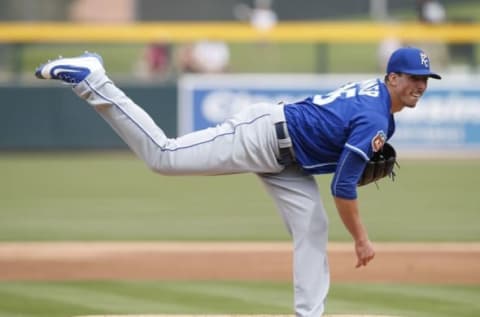
6. Kyle Zimmer, RHP
Birthdate: 9/13/91 (25 years old)
Level(s) Played in 2016: high A, AA
Stats in 2016: 5 2/3 IP, 1.59 ERA, 1.77 WHIP, 22.22 BB%, 40.74 K%
As long as Zimmer is able to lace ’em up, I’ll likely be a guy who ranks him. When you watch Kyle Zimmer pitch, he simply exudes the type of dominant attitude you want on the mound, and his performance matches the attitude as well.
After multiple seasons of injury issues that simply couldn’t be explained, Zimmer succumbed to Thoracic Outlet Syndrome surgery this season, which ended his season after 3 appearances that totaled less than six innings.
(Zimmer) has flashed elite stuff whenever he’s healthy enough to be on the mound
Zimmer was drafted #5 overall in 2012, and many considered him the best pitcher available in that season’s draft. He has flashed elite stuff whenever he’s healthy enough to be on the mound, but with the mounting stack of injury, it may be time to consider that elite stuff being elite bullpen stuff for the health of his arm.
Zimmer, when healthy, works with a fastball that can touch 97 and sits 92-95 with excellent movement. He’s touched triple digits in his past as well.
His primary off speed pitch is a power curve that simply makes hitters look foolish with its incredible break. He also throws a slider that has solid depth and late break along with a change that is above-average as well.
Zimmer could be an elite bullpen option if used in that role, akin to the success the team has seen with Wade Davis out of the bullpen after struggling as a starter.
Next: #5
5. Eric Skoglund, LHP
Birthdate: 10/26/92 (24 years old)
Level(s) Played in 2016: AA
Stats in 2016: 156 1/3 IP, 3.45 ERA, 1.11 WHIP, 5.97 BB%, 21.07 K%
A guy who was nearly completely off the prospect radar in his own system coming into the 2016 season, Skoglund has been the talk of anyone I ask about the Royals organization.
He’s the epitome of a command and control lefty, the type that has no standout pitch, but uses sequencing and excellent pitch location to make hitters miss or miss the meat of the bat, getting plenty of weak outs.
(Skoglund)’s the epitome of a command and control lefty
In a tough hitters league, the Texas League, Skoglund threw 156 innings with a .230 batting average against and walking less than 6% of all hitters he faced, an excellent sign of his chances of succeeding as a back-end starter in a big league rotation.
Skoglund uses his 6’7 frame to generate plane on all of his pitches, and his fastball may run only 88-92, but it plays faster due to the extension he gets toward home plate. He has excellent fade on his change, and his curve really does well in getting under hitters’ bats.
While Skoglund may not be a future ace profile, he’s the type that should be a major league starter sooner rather than later, likely even getting a start or two in 2017 for the big league club.
Next: #4
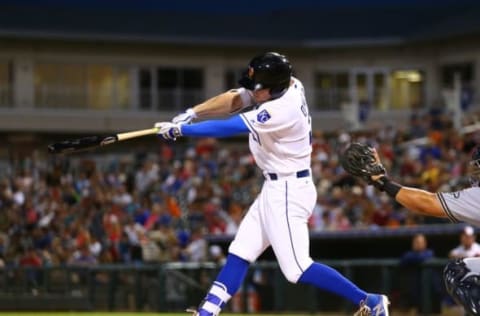
4. Ryan O’Hearn, 1B
Birthdate: 7/26/93 (23 years old)
Level(s) Played in 2016: high A, AA
Stats in 2016: .275/.351/.478, 22 HR, 3 SB
The Royals selected O’Hearn out of Sam Houston State seeing his powerful swing and excellent power frame physically and figured that his 11 career collegiate home runs could be improved.
O’Hearn has seen a minor adjustment to his swing to allow him more loft in his swing, but the big change is in his approach, as he’s been aggressive early in the count on pitches that he can drive, and it’s translated to big power numbers, including 32 doubles and 2 triples with his 22 home runs this season.
O’Hearn has seen a minor adjustment to his swing to allow him more loft in his swing
O’Hearn has the arm and fringe athleticism to handle left field, but he’s most likely going to profile as a first baseman going forward due to a limited speed profile.
He did show some struggles this season when he hit the upper minors and got a bit pull-happy in his first exposure to a hitter’s league and his swing got long in the back end, which led to a significant strikeout rate.
O’Hearn made solid impressions in Arizona in the AFL this year as a guy who was able to square up any velocity and nearly any breaking pitch for solid power. If he can push that forward to AAA in 2017, he could establish himself as the next 1B if Eric Hosmer chooses to leave via free agency after 2017.
Next: #3
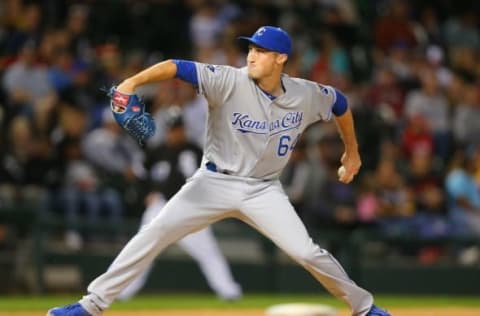
3. Matt Strahm, LHP
Birthdate: 11/12/91 (25 years old)
Level(s) Played in 2016: AA, MLB
Stats in 2016: 102 1/3 IP, 3.43 ERA, 1.22 WHIP, 5.41 BB%, 25.18 K% (minor league stats only)
When the Royals traded Brandon Finnegan (among others) last season for Johnny Cueto, many asked where they’d find another guy like him who had the ability to be a solid mid-rotation lefty starter but could also be an elite lefty reliever to both sides of the plate.
It turns out the Royals already had the guy in the system in Strahm. Strahm has a delivery that has raised some question since he was picked out of junior college in the 21st round of the 2012, and many blamed the delivery for his Tommy John surgery that cost him nearly his first two full seasons.
More from Kansas City Royals
- Kansas City Royals: John McMillon call-up is a development win
- Kansas City Royals: Trade with Atlanta Braves for Taylor Hearn confusing
- Kansas City Royals: What to expect from Cole Ragans
- Grading J.J. Picollo and the Kansas City Royals front office at the season’s midway point
- MLB bullpen report: A couple of things to keep an eye on in June
Delivery questions aside, Strahm has the repertoire to start, with a fastball that works in the low 90s and touches 96-97 in the bullpen. He compliments that with a tight curve that really gets excellent spin. His change is not an advanced pitch, but it’s certainly a solid enough pitch to keep opposite handed hitters honest from the rotation.
Strahm had an elite season in the major league bullpen, making 21 appearances with a 1.21 ERA, 1.09 WHIP, and a 11/30 BB/K ratio with a .173 opponents batting average. He was able to pitch to hitters from both sides with ease in the relief role as well.
The Royals saw Danny Duffy break through in 2016 after following the path of working as a reliever until the team felt he was ready to become a starter, and that could be Strahm’s path as well, or he could simply be the guy that takes Duffy’s rotation spot when Duffy leaves after the 2017 season (or via trade). Either way, he’ll likely start the season in the Royals bullpen in 2017.
Next: #2
2. Josh Staumont, RHP
Birthdate: 12/21/93 (22 years old)
Level(s) Played in 2016: high A, AA
Stats in 2016: 123 1/3 IP, 4.23 ERA, 1.69 WHIP, 17.93 BB%, 28.79 K%
Staumont was a guy who I knew would be on my top 10 based on my own viewings. I’m hard on guys who struggle to locate, and in the games I saw of Staumont in the Carolina League, he was unable to locate at all, but the stuff was evident and certainly top 10.
Then I kept hearing from guys that he was a clear top 3 prospect in the Royals system, especially those who were seeing him in the Arizona Fall League or had seen him in the Texas League.
More from Call to the Pen
- Philadelphia Phillies, ready for a stretch run, bomb St. Louis Cardinals
- Philadelphia Phillies: The 4 players on the franchise’s Mount Rushmore
- Boston Red Sox fans should be upset over Mookie Betts’ comment
- Analyzing the Boston Red Sox trade for Dave Henderson and Spike Owen
- 2023 MLB postseason likely to have a strange look without Yankees, Red Sox, Cardinals
Interestingly, the promotion to a hitter-friendly AA league in the Texas League seemed to be the trigger that unleashed the “good” Staumont, and he tore apart that league, with a 3.04 ERA and 1.57 WHIP over 50 1/3 innings at AA with a 37/73 BB/K ratio after having a nearly 1/1 BB/K ratio in the high-A Carolina League.
The Royals got Staumont in the 2nd round out of Azusa Pacific in the 2015 draft purely due to his monster velocity. He routinely sits in the mid-90s and has touched as high as 102 in short bursts with his four-seam fastball.
He works that with a two-seam sinking fastball that runs in the upper 90s and is near-impossible to square up. When he locates just his two fastballs, he is nearly untouchable, but there in lies the problem.
Staumont has issues with his mechanics due to high “explosion” in the body at multiple points of his delivery, which generates great velocity, but it also allows him to get off track in a real hurry in his location. Staumont showed an ability to keep the delivery much better in AA, but at that point, he showed the weakness of his two off speed pitches, a lazy curve that has a slow break and a change that really lacks movement.
If he can get his off speed stuff working and hold his delivery, he’s got the makings of an absolute ace in the game. However, there are dozens of pitchers that this could be said about on a yearly basis and one every 3-4 years actually does it. He should be an elite reliever with his pairing of the two elite fastballs if he cannot make it as a starter.
Next: #1
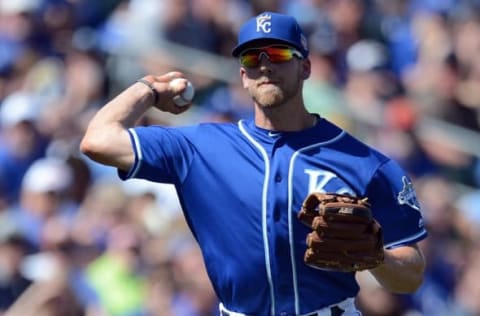
1. Hunter Dozier, 3B
Birthdate: 8/22/91 (25 years old)
Level(s) Played in 2016: AA, AAA, MLB
Stats in 2016: .296/.366/.533, 23 HR, 7 SB (minor league stats only)
The Royals turned some heads in the 2013 draft when they selected Dozier 8th overall, and when they turned around and used a significant above-slot bonus to select Sean Manaea in the supplemental first round, many assumed that Dozier was a cost saving move, but the Royals insisted all along that they felt Dozier was a legit top 10 talent in that year’s class.
Dozier advanced quickly, giving his team backing to their claim, reaching AA in his first full season in 2014, but then he struggled to produce there once he got there in 2014 or in 2015 when he repeated the level.
Heading back to AA for a third season was a short stay in 2016 as he needed only 26 games to show he was ready for AAA after knocking out 8 home runs in just 95 at bats.
Dozier has a swing that absolutely leads you to think there’s future power coming, and he shows that not only over the fence, but in his doubles as well, as he collected 44 doubles on the minor league season in 2016 to go with his 23 home runs.
Dozier is a solid defender at third, though he seems to suffer from mental lapses at the position, which has led to high error totals in spite of good instincts, good hands, and a fringe-plus arm with excellent accuracy. The Royals tried him in right field in the majors, and his arm and natural athleticism should play well in right if that’s a future home for him, though with Mike Moustakas due to hit the free agent market after the upcoming season, the Royals may only make that a temporary move.
Dozier will get every chance to compete for a major league job coming out of spring training, but he’s certainly re-established himself in the Royals’ future plans quite firmly.
Next: Newcomer To Watch
Newcomer To Keep An Eye On: Khalil Lee, OF
Birthdate: 6/26/98 (18 years old)
Level(s) Played in 2016: rookie
Stats in 2016: .269/.396/.484, 6 HR, 8 SB
If Matias is the most elite athlete in the system, Lee is the most elite raw baseball player.
Lee was considered a legit top 3 round selection as a hitter or a left-handed pitcher coming out of high school in Virginia with a fastball that touched 94 and two above-average breaking pitches.
The Royals and Lee instead chose to make him a hitter, and he flashed every bit of his across-the-board athleticism in his first year with the Arizona Rookie League.
Lee really does not have a standout tool, beyond his arm, but that’s primarily due to his relative lack of focus on his offensive skills to this point in his development. In watching his swing, there’s some fairly legit upside to Lee.
He profiles as a right fielder due to his arm and above-average speed in the outfield, though he is not likely to be a great base stealer as he doesn’t have great first-step quickness.
Lee’s offensive profile will peak in his contact and power as he showed advanced pitch recognition, especially considering his lack of polish as a hitter. He has quick wrists and gets surprising jump off the bat from his 5’10 frame that allows him to drive balls. At the very least, that power will drive balls to every gap.
He’ll likely start in the Pioneer League in 2017, and he and Matias should be a fun pairing to watch develop together.
Agree? Disagree? Someone you have a question about from the system? Leave a comment down below!